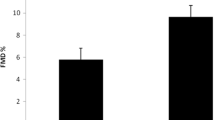Abstract
Conclusive data about the prevalence of endothelial dysfunction and atherosclerotic process in ankylosing spondylitis (AS) patients with respect to the general population are lacking. Elevated plasma levels of asymmetric dimethylarginine (ADMA), an endogenous inhibitor of nitric oxide synthase, have been reported in clinical conditions associated with endothelial dysfunction and atherosclerotic disease. We performed a cross-sectional study to evaluate plasma ADMA levels and atherosclerotic disease in AS patients. Seventeen consecutive AS patients free of any cardiovascular disease and 17 healthy controls [strictly matched for sex, age (±5 years) and atherosclerotic risk factors] were recruited. Plasma ADMA levels were assessed by capillary electrophoresis. Common carotid artery intima–media thickness (CCA-IMT), flow-mediated dilatation (FMD) and arterial stiffness (aS) were registered as surrogate markers of atherosclerotic disease. Plasma ADMA levels appeared significantly (p = 0.001) higher in AS patients (0.65 ± 0.10 μmoli/L) than in the control subjects (0.54 ± 0.07 μmoli/L) while no statistically significant differences between AS and controls were demonstrated in CCA-IMT, FMD, and aS. AS patients showed increased plasma ADMA levels with respect to control subjects. On the contrary, we were not able to document a significant difference in atherosclerotic process between patients and controls.
Similar content being viewed by others
References
Lehtinen K (1993) Mortality and causes of death in 398 patients admitted to hospital with ankylosing spondylitis. Ann Rheum Dis 52(3):174–176
Radford EP, Doll R, Smith PG (1977) Mortality among patients with ankylosing spondylitis not given X-ray therapy. N Engl J Med 297(11):572–576, sep 15
Zochling J, Braun J (2008) Mortality in ankylosing spondylitis. Clin Exp Rheumatol 26(5 Suppl 51):S80–S84
Peters MJ, van der Horst-Bruinsma IE, Dijkmans BA et al (2004) Cardiovascular risk profile of patients with spondylarthropathies, particularly ankylosing spondylitis and psoriatic arthritis. Semin Arthritis Rheum 34(3):585–592
Mathieu S, Joly H, Baron G et al (2008) Trend towards increased arterial stiffness or intima–media thickness in ankylosing spondylitis patients without clinically evident cardiovascular disease. Rheumatology (Oxford) 47(8):1203–1207
van Eijk IC, Peters MJ, Serne EH et al (2008) Microvascular function is impaired in ankylosing spondylitis and improves after TNFα blockade. Ann Rheum Dis 68(3):362–366
Malesci D, Niglio A, Mennillo GA et al (2006) High prevalence of metabolic syndrome in patients with ankylosing spondylitis. Clin Rheumatol 26(5):710–714
Choe JY, Lee MY, Rheem I et al (2008) No differences of carotid intima–media thickness between young patients with ankylosing spondylitis and healthy controls. Joint Bone Spine 75(5):548–553
Wang D, Gill PS, Chabrashvili T et al (2007) Isoform-specific regulation by N(G) N(G)-dimethylarginine dimethylaminohydrolase of rat serum asymmetric dimethylarginine and vascular endothelium-derived relaxing factor/NO. Circ Res 101(6):627–635
Van der Linden S, Valkenburg HA, Cats A (1984) Evaluation of diagnostic criteria for ankylosing spondylitis. A proposal for modification of the New York criteria. Arthritis Rheum 27(4):361–368
Garrett S, Jenkinson T, Kennedy LG et al (1994) A new approach to defining disease status in ankylosing spondylitis: the Bath Ankylosing Spondylitis Disease Activity Index. J Rheumatol 21(12):2286–2291
Calin A, Garrett S, Whitelock H et al (1994) A new approach to defining functional ability in ankylosing spondylitis: the development of the Bath Ankylosing Spondylitis Functional Index. J Rheumatol 21(12):2281–2285
Zinellu A, Sotgia S, Zinellu E et al (2007) High-throughput CZE-UV determination of arginine and dimethylated arginines in human plasma. Electrophoresis 28(12):1942–1948
Sari I, Okan T, Akar S et al (2006) Impaired endothelial function in patients with ankylosing spondylitis. Rheumatology (Oxford) 45(3):283–286
Böger RH (2003) The emerging role of ADMA as a novel cardiovascular risk factor. Cardiovasc Res 59(4):824–833
Leiper JM, Santa Maria J, Chubb A et al (1999) Identification of two human dimethylarginine dimethylaminohydrolases with distinct tissue distributions and homology with microbial arginine deiminases. Biochem J 343(Pt 1):209–214
Surdacki A, Martens-Lobenhoffer J, Wloch A et al (2007) Elevated plasma asymmetric dimethyl-l-arginine levels are linked to endothelial progenitor cell depletion and carotid atherosclerosis in rheumatoid arthritis. Arthritis Rheum 56(3):809–819
Sari I, Kebapcilar L, Alacacioglu A et al (2009) Increased levels of asymmetric dimethylarginine (ADMA) in patients with ankylosing spondylitis. Intern Med 48(16):1363–1368
Teerlink T (2005) Measurement of asymmetric dimethylarginine in plasma: methodological considerations and clinical relevance. Clin Chem Lab Med 43(10):1130–1138
Schulze F, Wesemann R, Schwedhelm E et al (2004) Determination of asymmetric dimethylarginine (ADMA) using a novel ELISA assay. Clin Chem Lab Med 42(12):1377–1383
Zoccali C, Bodie-Böger SM, Mallamaci F et al (2001) Asymmetric dimethylarginine (ADMA): an endogenous inhibitor of nitric oxide synthase predicts mortality in end-stage renal disease (ESRD). Lancet 358:2113–2117
Ito A, Tsao PS, Adimoolam S et al (1999) Novel mechanism for endothelial dysfunction: dysregulation of dimethylarginine dimethylaminohydrolase. Circulation 99(24):3092–3095
Hürlimann D, Forster A, Noll G et al (2002) Anti-tumor necrosis factor-α treatment improves endothelial function in patients with rheumatoid arthritis. Circulation 106:2184–2187
Fiskerstrand T, Ueland PM, Refsum H (1997) Folate depletion induced by methotrexate affects methionine synthase activity and its susceptibility to inactivation by nitrous oxide. J Pharmacol Exp Ther 282:1305–1311
Maas R, Xanthakis V, Polak JF et al (2009) Association of the endogenous nitric oxide synthase inhibitor ADMA with carotid artery intimal media thickness in the Framingham Heart Study offspring cohort. Stroke 40(8):2715–2719
Chambless LE, Folsom AR, Clegg LX et al (2000) Carotid wall thickness is predictive of incident clinical stroke: the Atherosclerosis Risk in Communities (ARIC) Study. Am J Epidemiol 151(5):478–487
Disclosures
None
Author information
Authors and Affiliations
Corresponding author
Rights and permissions
About this article
Cite this article
Erre, G.L., Sanna, P., Zinellu, A. et al. Plasma asymmetric dimethylarginine (ADMA) levels and atherosclerotic disease in ankylosing spondylitis: a cross-sectional study. Clin Rheumatol 30, 21–27 (2011). https://doi.org/10.1007/s10067-010-1589-x
Received:
Revised:
Accepted:
Published:
Issue Date:
DOI: https://doi.org/10.1007/s10067-010-1589-x




